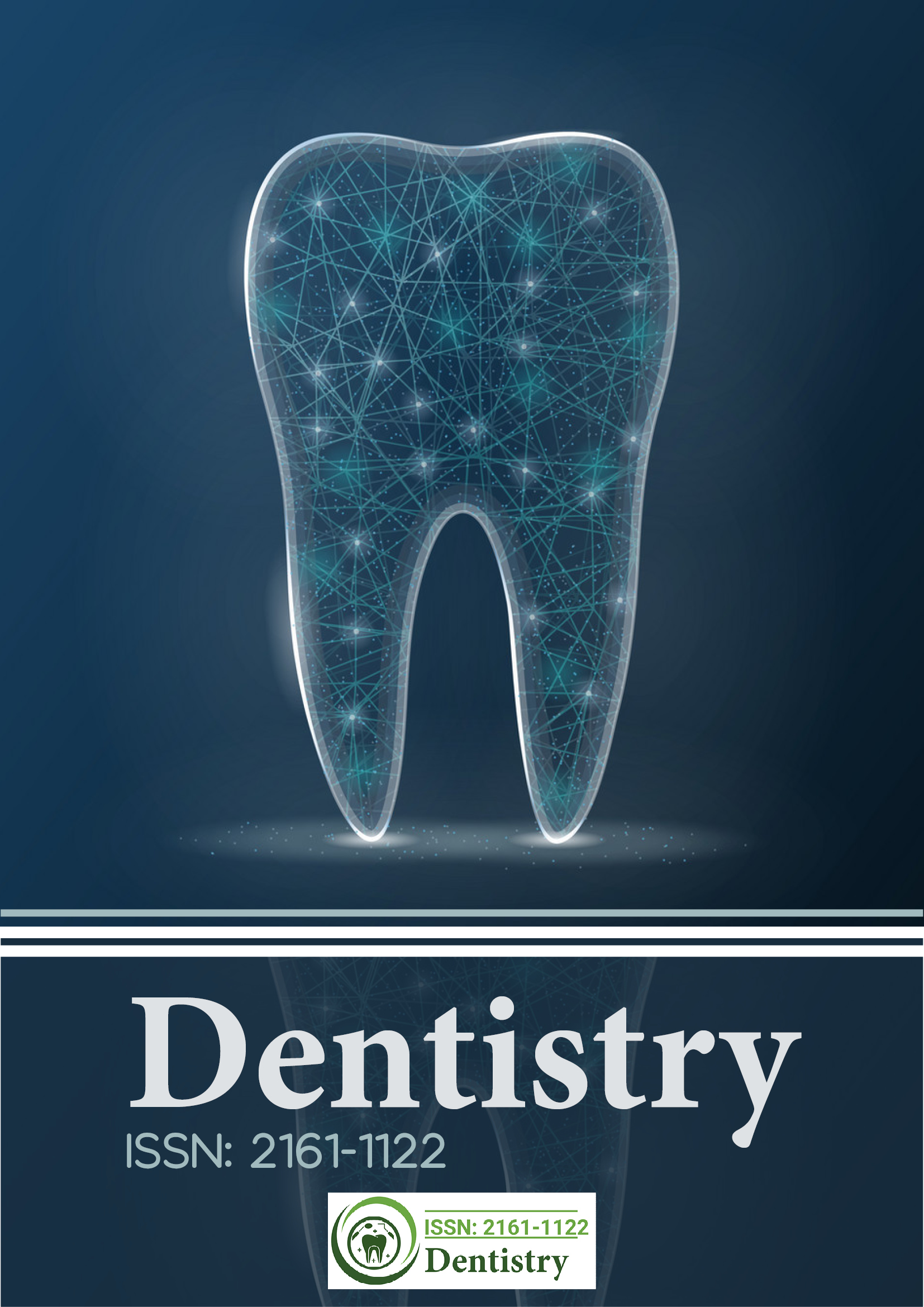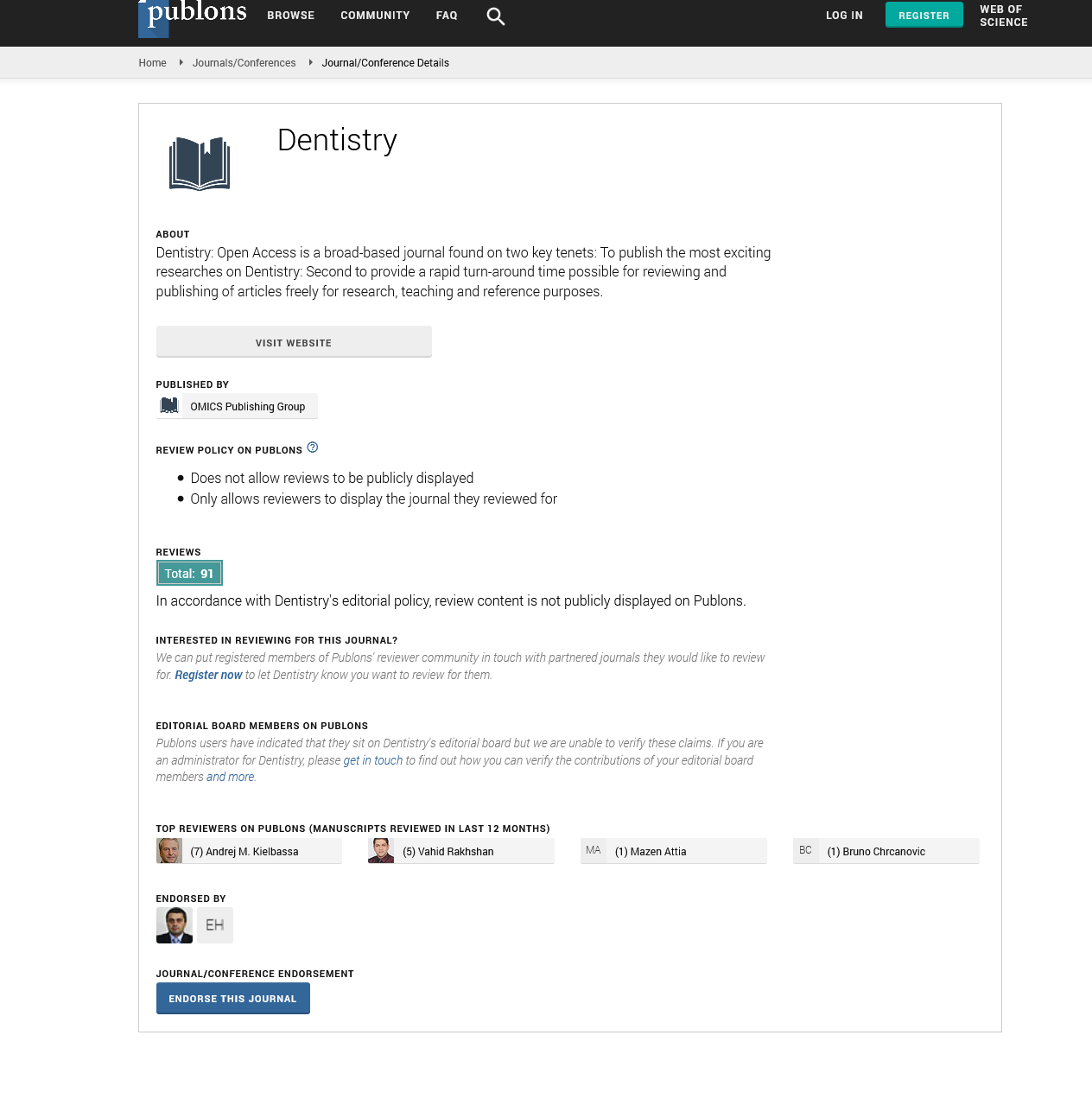Citations : 2345
Dentistry received 2345 citations as per Google Scholar report
Indexed In
- Genamics JournalSeek
- JournalTOCs
- CiteFactor
- Ulrich's Periodicals Directory
- RefSeek
- Hamdard University
- EBSCO A-Z
- Directory of Abstract Indexing for Journals
- OCLC- WorldCat
- Publons
- Geneva Foundation for Medical Education and Research
- Euro Pub
- Google Scholar
Useful Links
Share This Page
Journal Flyer

Open Access Journals
- Agri and Aquaculture
- Biochemistry
- Bioinformatics & Systems Biology
- Business & Management
- Chemistry
- Clinical Sciences
- Engineering
- Food & Nutrition
- General Science
- Genetics & Molecular Biology
- Immunology & Microbiology
- Medical Sciences
- Neuroscience & Psychology
- Nursing & Health Care
- Pharmaceutical Sciences
Commentary - (2022) Volume 12, Issue 8
Evaluating a Triple Antibiotic Paste as an Obturating Substance for Primary Teeth
Tedner Zahra*Received: 01-Jul-2022, Manuscript No. DCR-22-18028; Editor assigned: 04-Jul-2022, Pre QC No. DCR-22-18028 (PQ); Reviewed: 21-Jul-2022, QC No. DCR-22-18028; Revised: 29-Jul-2022, Manuscript No. DCR-22-18028 (R); Published: 05-Aug-2022, DOI: 10.35248/2161-1122.22.12.594
About the Study
Primary teeth are crucial for chewing, jaw development, occlusion, space maintenance, and the direction of the eruption of permanent teeth. They are also thought to be crucial for phonetics, attractiveness, and psychological health. Tooth caries is one of the most common pediatric disorders, destroying dental tissues at a rate of 20%-76% on average. It weakens the structural integrity of teeth, allowing micro-organisms to enter endodontic spaces. Pure aerobic, anaerobic, and mixed grampositive and gram-negative cocci, bacilli, and fungi were among the microbial species isolated from the root canals of such teeth. The pulps of such compromised teeth suffer irreversible damage, making them incapable of withstanding normal function for an extended period in the oral cavity.
Endodontic therapy, which is largely focused on the eradication of causative agents responsible for endodontic infections, is achieved to preserve such teeth in the dental arch. Mummification pulpotomy, partial pulpotomy, and pulpectomy are among the available therapeutic options. Pulpotectomy is the preferred treatment for teeth with necrotic pulp or teeth that lack pulp. Cleaning and shaping the endodontic gaps removes the germs and their byproducts that cause the start and development of endodontic illnesses. The physiology of the primary teeth is different from those of their successors because, as the permanent teeth erupt, the roots of the primary teeth resorb. In contrast to permanent teeth, which have obturating materials used to fill their root canals, this trait changes the endodontic treatment of primary teeth.
The optimum bioresorbable obturating substance is used to fill the endodontic gaps of primary teeth after thorough disinfection in order to hermetically seal them and keep them clean and healthy throughout their course. The obturating materials utilized for this purpose should meet all the criteria for the perfect obturating material, as well as have the best antibacterial activity and biocompatibility with the surrounding tissues. Zinc- Oxide Eugenol (ZOE) and its variants (traditional materials) or Ca(OH)2 Iodoform paste Endoflas, Guedes-Pinto paste, KRI paste, and Maisto paste are the several principal root canal obturating materials utilised for this purpose (contemporary materials).
Despite being utilised in clinical practise for a long time, these materials have shown few flaws, such as poor antibacterial ability to get rid of the lingering microorganisms, cytotoxicity, and related unpleasant responses. For ZOE and Ca(OH)2 Iodoform paste, the failure rate of endodontic therapies including these obturating materials has been estimated to be between 15% and 35%. The causes of these failures are linked to cytotoxicity, various related adverse responses, and the inability of the obturating materials to completely eradicate all forms of microorganisms, including vegetative and non-vegetative ones. Researchers looked for a viable replacement that would have sufficient antibacterial activity and biocompatibility during use as a result of the problems found with prior obturating materials.
The idea of an intracanal antibiotic medication was the first, but it later developed into lesion sterilisation, tissue healing, and triple antibiotic paste. The majority of the endodontic microorganisms were eradicated with this substance, which combined Ciprofloxacin, Metronidazole, and Minocycline with a few vehicles to generate a novel therapeutic modality with potential antibacterial effects. However, after some time due to a high concentration of antibiotics in it, this technique also exhibited certain flaws in the form of local and systemic adverse reactions10, diminishing its reputation as an obturating material in primary teeth.
Antibiotic mixtures were utilised in the form of TAP (Triple Antibiotic Paste) to increase antibacterial efficacy and solve issues with commonly used obturating agents like Ca(OH)2 Iodoform and ZOE. However, it was changed into DAP once it was discovered that Ciprofloxacin and Minocycline had issues (double antibiotic paste). However, because tetracycline or its derivatives could not be used, it was unable to meet the criteria for an ideal obturating substance. Testing and reinforcement of the TAP modified with clindamycin and doxycycline have been completed. Despite the positive outcomes of this method, the material was unable to become widely used as an obturating material for primary teeth due to its negative side effects, including cytotoxicity and biocompatibility with periapical tissues.
Citation: Zahra T (2022) Evaluating a Triple Antibiotic Paste as an Obturating Substance for Primary Teeth. J Dentistry. 12:594.
Copyright: © 2022 Zahra T. This is an open access article distributed under the terms of the Creative Commons Attribution License, which permits unrestricted use, distribution, and reproduction in any medium, provided the original author and source are credited.

